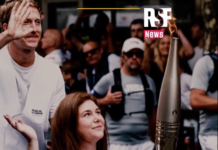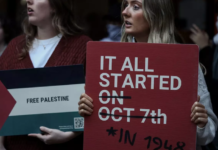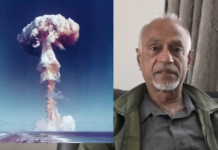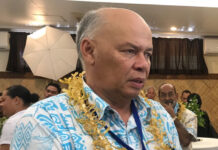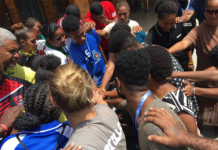
OBITUARY: By Sri Krishnamurthi, contributing editor of Pacific Media Watch
Before Ben Ryan (2016 Fiji gold medal winners at the Rio Olympics) there was George Simpkin, officially the technical director, but in fact Fiji coach at the 1987 rugby World Cup.
Last week he died aged 76 at his Waikato home, but that is not how I remember him.
The year 1987 was the time of the first Fiji military coup by Lieutenant-Colonel Sitiveni Rabuka who I interviewed two years ago and who repeatedly apologised for carrying out the coup – but I digress.
READ MORE: International rugby community farewells George Simkin
As the sports editor at The Fiji Times at the time – along with my Fiji Sun colleague Matai Akoula who once saved me from a “mob lynching” at Nadi’s Prince Charles Park after a Farebrother Sullivan Challenge Trophy match (akin to the Ranfurly Shield here in New Zealand) when Nadi lost to Suva – we both found George a warm, kind-hearted man.
However, he could bristle like a man standing before you with hand on slim hips with a hernia. He could look so pained at what you had written, like you had done him so wrong – all about rugby.
Many a time, he strode into the old Gordon Street wooden building of The Fiji Times to lean on my desk while he fired questions at me,”why…did you write that”. And the whys came thick and fast followed by the inevitable “what were you thinking of when you wrote that?”
To the stage where he asked me to attend a clinic at the Fiji Rugby Union where he explained the finer points of forward play.
Role of the hooker …
What the loosehead did, what the tighthead did and the role of the hooker; but much more than that …what was function of the first lock, second lock and the loose forwards.
“The number 7 is first at the breakdown, followed by the number 8 and then the number 6, with locks and the props coming after,” he explained then.
For a boy who had hopes of doing a football degree in Germany, and being an Indo-Fijian, rugby didn’t come naturally to me.
I finally understood rugby, and did I love it – and that is why I think Sir Michael Jones was peerless as a Number 7. Thanks to George Simpkin.
He was head coach of Waikato from 1976-1984, taking the Ranfurly Shield off Auckland, moving the province into first division. He would have loved to coach the All Blacks, and to me it was a mystery why he wasn’t selected.
George grabbed opportunities to coach in Fiji then Hong Kong, China, Sri Lanka and Germany.
And he took to drinking yaqona like it was going out fashion, many a talanoa (chat) was had over a bilo (bowl) or three.
Fijian gait
As he explained to me at one such sitting, the Fijian gait was such that it was more suited to rucking than mauling because in the tropical climate Fijians tended to conserve their upper body energy.
So, he taught the Fijians the ruck-and-run game that worked so well at the first rugby World Cup and took them to the quarterfinals against France.
However, I did collaborate with him in getting Fiji to 1987 World Cup.
The book Real Men Drink Aftershave, by Alison Kervin, accurately describes this:
“… [B]ut the outside world still had no idea whether the Fijians would be in New Zealand. Sri Krishnamurthi, sports editor of The Fiji Times newspaper arrived at his desk only to be told by the editor that the rumours were circulating that Fiji were going to be replaced by Samoa….Krishnamurthi said he didn’t think so but would find out for definite. He headed down to the military base (where Fiji were training) and told Simpkin there were huge concerns in New Zealand. ‘We will be there,’ said Simpkin…’Leave it to me I’ll tell them’.”
“Krishnamurthi rushed back to phone his friend Dean McLachlan at Rugby News in Auckland but he couldn’t get a line out of the country. He dialled the operator and explained that he needed to get a message to New Zealand urgently to say the Fijian team would be at the World Cup, she opened the line and put him through to Auckland. Krishnamurthi duly spoke to McLachlan who passed the message to NZRFU that the Fijians were coming.”
And that’s how Fiji came to play in the first rugby World Cup in 1987 just a mere couple of weeks after the first military coup.
George Simpkin accumulated a wealth of achievements at school, club, provincial and international rugby level but on May 7, the 76-year-old husband and father lost his battle with cancer at Waikato Hospital in Hamilton.
Haere Ra George, Fiji will remember you with great fondness.


